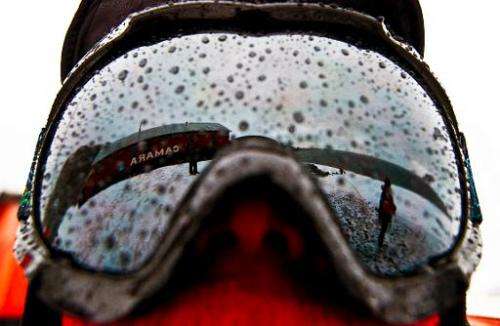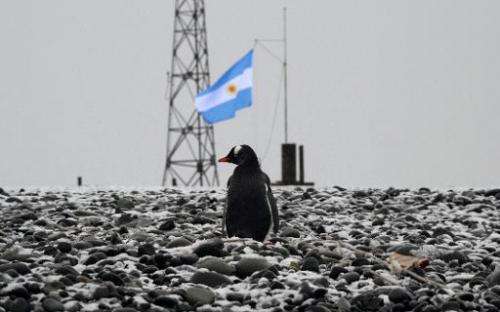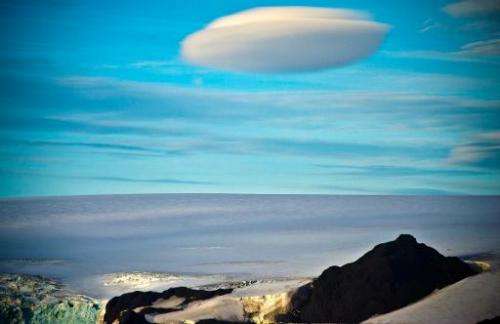Argentinian military base of Camera is reflected on a scientist's glasses in Antarctica during a mission of the Brazilian Navy's Oceanographic Ship Ary Rongel on March 8, 2014
Furious ten-meter waves and icy, tempestuous gales await those intrepid enough to navigate Drake Passage, the crossing from the tip of South America to Antarctica seen by seafarers as one of the world's most dangerous voyages.
After an interminable 43-hours trip negotiating waters that leave even experienced sailors queasy, the crew and a gaggle of reporters aboard the Brazilian icebreaker and oceanographic research vessel Ary Rongel finally spot land.
As night falls, huge blocks of ice can just be discerned on the horizon, the still blurred contours of King George Island, the largest of the South Shetland Islands and home to a Brazilian research base.
"It is very emotional. The landscape is stunning and you can breathe very pure air," Sergeant Adilson Pinheiro, a 25-year-veteran with the Brazilian navy, tells AFP.
"We can see different animals, such as penguins and sea lions. It is fantastic, very gratifying. This makes up for missing your family—and for the crossing."
The Ary Rongel is transporting personnel along with provisions for Brazil's Comandante Ferraz Antarctic Station, host to the Brazilian Antarctic Program of scientific research.
The base, inaugurated in 1984, is currently being refurbished with inhabitants living in provisional accommodation units after a fire ripped through it two years ago, killing two staff.
Natural beauty and hostility
Drake Passage, which stretches for some 1,000 kilometers (540 nautical miles), represents three-quarters of the voyage from the Chilean city of Punta Arenas to the Antarctic.
"Drake Passage is feared as it is one of the worst seas in the world, if not the worst, to navigate", says 31-year-old skipper, Lieutenant Ricardo Magalhaes.
View of a penguin at the Argentinian military base of Camera in Antarctica taken during a mission of the Brazilian Navy's Oceanographic Ship Ary Rongel on March 8, 2014
"West to east it is buffeted by strong winds and many cold fronts with nothing in the way of physical barriers to break the waves which in summer can rise as high as eight to ten meters.
"But good seas don't make for good sailors," muses the navigation specialist, who has 14 years naval service behind him.
It was the lieutenant's Portuguese near namesake Ferdinand Magellan who, financed by the Spanish crown, headed the first expedition to sail from the Atlantic Ocean into the Pacific in 1520 seeking a trade route to the Far East.
After a four-day trip punctuated by poor sleep and seasickness tablets, the Ary Rongel's passengers are up on deck to survey the scenery wide-eyed.
A flock of petrels marks their arrival in a world of natural beauty but also danger.
For a while the waters are calm as the vessel slips into the Strait of Magellan and heads south through Chilean waters, a 600-kilometer trek which takes 30 hours to navigate.
Locally, they call it the Avenue of Glaciers or "ventisqueros"—a mountainous area wheres snow and ice still lies deep on the peaks even as the Patagonian summer approaches its end.
From there, Ary Rongel steers into Richmond Passage and out into Drake Passage, where the Atlantic and the Pacific meet.
View of Antarctica from the Brazilian Navy's Oceanographic Ship Ary Rongel on March 4, 2014
Military routine
Days on board the Ary Rongel, affectionately dubbed "Red Giant" by its crew because to its bright red paint, are characterized by strict military routine.
Each day starts at dawn and four mealtimes are rigidly adhered to.
Communications, activities for the day and information on temperature and how long a human being can survive in the sea should the vessel sink are all broadcast over the shipboard PA.
The 82-strong crew, all military, carry out a range of functions from cook to diver, pilot to mechanic, chaplain to commander.
Another 23 civilians—scientists and journalists—make up the remainder of the 105 passengers.
On each mission, the crew stay aboard from October to April and will generally make five trips down to the base during that period.
Joining the Ary Rongel, another Brazilian Navy vessel, the Almirante Maximiano, offers logistic support to the group of researchers at the base and elsewhere in the Antarctic, bringing supplies and equipment and taking away trash.
Hercules C130 transports from the Brazilian Air Force also lend logistical support, flying in and out of Chile's Frei base, which has a landing strip that Brazil's own base lacks.
© 2014 AFP
























